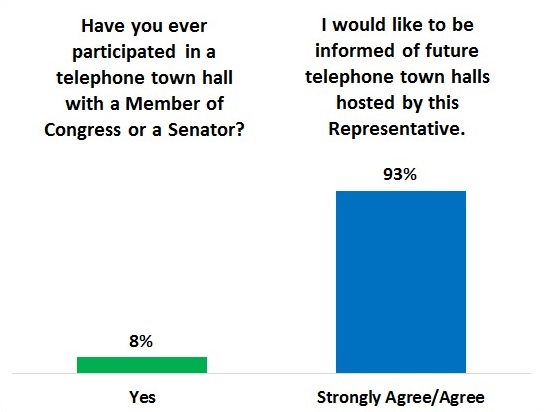Constituents like to know they were heard and that their participation made a difference, even when they disagree with the result. There are many ways you can follow-up from telephone town hall meetings, though you need to balance the effort required against the value gained to both the Member and constituents. There are better ways of following up than responding one-on-one to constituents whose questions weren't addressed during the meeting.
Why You Should Do This
Prior to our experiment, 92% of citizens had never participated in a telephone town hall with a Representative or Senator, though 64% strongly agreed and 29% agreed that they would like to be informed of future telephone town halls. This number remained high after participating in a session, with 91% saying they would like to be informed of future events. Offices that aren’t hosting telephone town halls are clearly missing an opportunity to connect with their constituents.
What We Learned
-
Extend the life of the meeting. With a fairly low effort, you can engage more people simply by posting information about—or audio or video from—the meeting on your website and social media. You can also get the word out via paper or electronic newsletters and mentions at in-person venues. Making it accessible to others who did not attend helps to demonstrate an interest in being inclusive, transparent and accountable. Answering some of the questions there wasn't time for—including a tough one or two—also helps engender trust. It has the added benefit of ensuring the response is shared with more people, which broadens the impact.
-
Keep the conversation going. There are a variety of ways to integrate town hall meetings into the work of the office to keep them alive without creating much extra work for staff. For example, if staff members capture the first names of constituents, their towns, and questions asked, they can be referenced in other venues. Same with quotes. Those interactions can become small moments for blogs, newsletters, floor speeches, meetings, and social media posts. For example, "I thought about Sarah from Capitol City in committee today. She asked me about x at my last town hall meeting, and . . ." By referencing what happens in the meetings you not only keep the conversation going, you demonstrate that you're listening and that the meetings are worth attending.
-
Build on it. Instead of viewing each meeting as a separate event, think about ways to link them together and build on them. Start a notification list of people who want to be invited and develop relationships with them. Create a Twitter hashtag and/or a private Facebook page for ongoing discussion among participants and weigh in from time to time. Facilitate a series in different ways to get different types of feedback. Include some staff-led events that follow up on the meetings. If you build enough momentum on an issue, you might even consider establishing an advisory group on an important topic.



